Gistok Member Username: Gistok Post Number: 2887 Registered: 08-2004 |
Many of the wonderful buildings downtown have beautiful sculptural detailing that are made of TERRA COTTA, a clay material that was turned into an art form in the first half of the 20th century. Some of the best terra cotta building skins are found along lower Woodward. One of my favorites is the Broadway side of the Detroit Opera House with its' Corinthian columned classical facade. Of course, terra cotta was part of "that old stuff" that went out of fashion during the International Style of the mid 20th century. But it is so useful, and so sculptural in its versatility. But today terra cotta is only used for building restorations, by the few companys that do restoration work. Terra cotta has definitely withstood the test of time as a durable building material. It's too bad that it doesn't see a resurgence. It would be an excellent building material in the Post-Modern sense. It would give modern architects a great way to add interest to modern designs. Way better than molded concrete! | ||
Barnesfoto Member Username: Barnesfoto Post Number: 2571 Registered: 10-2003 |
You're in America now! Why won't you speak English?! | ||
Danindc Member Username: Danindc Post Number: 1811 Registered: 10-2003 |
The problem with terra cotta is that it is, in fact, NOT a durable building material. It is quite brittle, and fractures very easily. In the late 19th century, many floor systems were constructed using terra cotta arches, both curved and flat. The terra cotta blocks had to be installed very carefully--breaking one block would render the floor system useless. For this reason, concrete came into vogue. I know you're most likely talking about pure ornamentation. Terra cotta remains very brittle, though, which makes it difficult to manufacture and ship. There are other issues, but I won't get into them here. | ||
Dabirch Member Username: Dabirch Post Number: 1892 Registered: 06-2004 |
Yeah, I know what you mean. These guys have barely withstood the test of time. 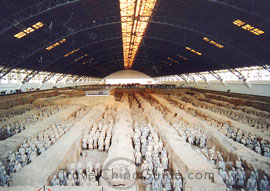 | ||
Danindc Member Username: Danindc Post Number: 1813 Registered: 10-2003 |
Can't quite see what's in the photo. Can you describe? | ||
Ray1936 Member Username: Ray1936 Post Number: 838 Registered: 01-2005 |
That's them Chinese guys guarding the Emperor from a zillion years ago. But they weren't exposed to Michigan weather. | ||
Danindc Member Username: Danindc Post Number: 1814 Registered: 10-2003 |
...or any kind of impact, pollution, or what-have-you. They were buried in soil, which conveniently prevented them from moving at all. Looks pretty dry in there, too. Art has been made out of plaster too, dabirch. Do you propose that plaster is an extremely durable building material as well? | ||
Goat Member Username: Goat Post Number: 8873 Registered: 10-2003 |
Any terra cotta that I have seen seems to hold up reasonably well in this area. I don't think your argument holds much weight DaninDC. | ||
Lmichigan Member Username: Lmichigan Post Number: 4536 Registered: 10-2003 |
I'm just wondering if Gistok's post has a question somewhere in the post, or was supposed to initiate discussion, because I see neither. I'm confused to say the least. | ||
Sumotect Member Username: Sumotect Post Number: 247 Registered: 08-2004 |
I worked on a brand new building that used terra cotta panels, back in the early eighties. It was a corporate headquarters building in Souix City, Iowa. Terra cotta is a fabulous material to work with. It is extremely versatile in the sense that the surface can be made to look like anything the architect desires. We tend to think of terra cotta as being like the clay pots, or the gleaming white terra cotta that was made popular at the Chicago Exposition in 1893, but it can be made in any color and texture desired, even faux stone. The tiles were 2’ by 2’ and colored a bright emerald green. After the tiles were made they were cast into a concrete panel also 2’ by 2’. The concrete kept the tiles from flexing and breaking and also allowed the building to be detailed like a pre-cast concrete structure. I have also seen it used in panelized form. Not used nowadays because no one makes it. At the time there was only one company that could do it Glading Mcbean, in California. It is an almost lost art. Expensive to ship, Expensive period. Similar effects are now created with fiberglass panels. | ||
Lmichigan Member Username: Lmichigan Post Number: 4537 Registered: 10-2003 |
Yeah, terra cotta that is replaced, today, on most historic buildings is now with the GFRC (Glass Fiber Reinforced Concrete) EIFS systems. The facade treatment for every building in the Merchants Row redevelopment was that of GFRC as it's much cheaper (i.e. much less labor-intensive). | ||
Rjlj Member Username: Rjlj Post Number: 157 Registered: 11-2003 |
The Terra Cotta that was used on historic buildings was not robust and would deteriorate. That is why most of the terra cotta on buildings was replaced, it would crumble on to the sidewalk below. Rather than have it fall on people, it was sometimes replaced with a crappy looking cement substitute. Changes in what was popular in design was not necessarily the reason. | ||
Lmichigan Member Username: Lmichigan Post Number: 4541 Registered: 10-2003 |
I don't think anyone said that it was changes in what was popular. In fact, everyone seems to be saying that it was cost and construction. | ||
Patrick Member Username: Patrick Post Number: 3614 Registered: 10-2003 |
Dumb question: Did they ever put any kind of sealant over Terra Cotta to protect from rain and snow? | ||
Jimaz Member Username: Jimaz Post Number: 722 Registered: 12-2005 |
That actually sounds like a pretty good question to me. | ||
Lmichigan Member Username: Lmichigan Post Number: 4542 Registered: 10-2003 |
I have another question, where the terra cotta panels on most of these old buildings build using applied masonry, or were most on curtain wall systems? I think that would make a huge difference in maintenance. I'd imagine that most of them are applied masonry facades, which would be harder (i.e. more costly) to maintain. | ||
Jasoncw Member Username: Jasoncw Post Number: 249 Registered: 07-2005 |
Terra Cotta is almost always glazed, giving it color and protection from water, but once water gets in, from what I understand it does damage. But terra cotta is a material I'm really interested in. As far as I know now, it's a good way to put in a lot of repetetive detail into a building. | ||
Lowell Board Administrator Username: Lowell Post Number: 3060 Registered: 10-2003 |
Speaking of Terra Cotta. Remember the Lee Plaza Lions? They held up pretty good since the 20's... 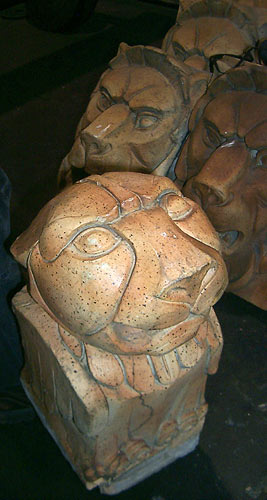 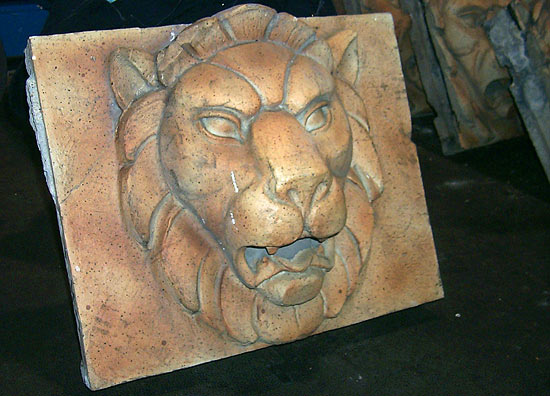 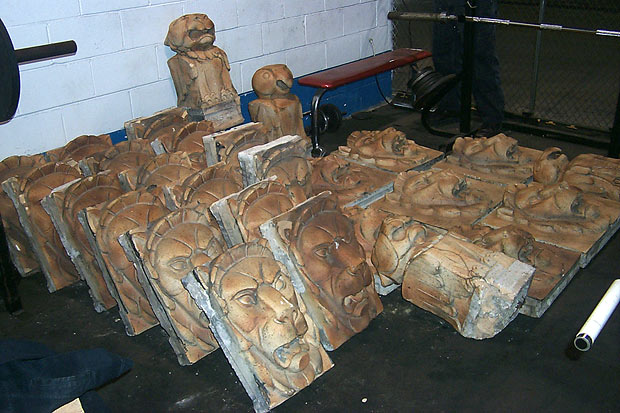 | ||
Gistok Member Username: Gistok Post Number: 2890 Registered: 08-2004 |
Lmichigan... I was doing a "Linda Richmond"... the Mike Myers verklempt Jewish talkshow hostess from Saturday Night Live in the 1990's when she said... "I'll throw out a topic.... discuss!" Seems like not a lot of new discussions around here lately... just politics and mud slinging... Now back to the thread... The Detroit Opera House spent well in excess of $1 million dollars to fix all the damaged Terra Cotta on the Broadway side of the Opera House, an expensive undertaking. I'm not sure, but I bet they replaced the damaged sections with real terra cotta. Terra cotta may not be as durable as hard stone, but I bet it is more durable than sandstone, and probably as durable as brick. Those Lee Plaza lions didn't look too bad for 80 year old terra cotta, and that building has been unheated and abandoned for a long time. I'm no expert, but perhaps like everything else, maintenance and upkeep are the key to preserving terra cotta. And I'm sure that sunbelt locations preserve terra cotta much better due to the lack of the thaw/freeze cycle found in the northern climate. What got me off on this tangent was a book on Art Deco I have that mentions 2 chain stores that used terra cotta on their stores. One was F.W. Woolworths, which used a special creamy-white Washington state clay in their terra cotta storefronts. This was produced by that same Gladding, McBean Co. (that Sumotech mentioned) of Lincoln City CA. A 2nd chain store was one called S.H. Kress, which created some really wonderful Art Deco terra cotta storefronts. The Art Deco book in question "REDISCOVERING ART DECO USA" by Barbara Capitman (the savior of Miami Beach Deco), says this about terra cotta: "Terra-cotta, which means baked earth, is a very strong and durable building material that has been used for centuries. Compared to stone it is much lighter and much less expensive, factors that led to its increasing use in the United States as skyscrapers grew taller and taller, thus giving architects (in the 1920's & 30's) an inexpensive, yet artistic means to enliven their buildings." | ||
Lmichigan Member Username: Lmichigan Post Number: 4543 Registered: 10-2003 |
The Cadillac Square Apartments are another great example of terra-cotta. It looks great when to sun plays off the facade. BTW, while we're talking of terra-cotta, there is a cool old Art Modern-styled building in downtown Lansing, the old Knapp's Department Store, faced in a very rare material: Macotta. Macotta tiles are metal panels coated in colored enamel. I don't think I've ever seen these anywhere else. Here's one of the photos I took of the building: Knapp's Centre 1. http://static.flickr.com/35/115738077_2842b1849c_o.jpg Look how the sun reflects off of it. (Message edited by lmichigan on October 06, 2006) | ||
Michikraut Member Username: Michikraut Post Number: 180 Registered: 05-2004 |
Terra Cotta is actually more weather resistant than many natural Stone products and bricks due to closed pores(glazing), therefore less absorption of liquids. The problem of falling terra-cotta ornamentation from turn of the century buildings usually has little to due with the actual Terra Cotta but more with the fastenings and attachment procedure. In some aspects the Ornamentation(Cornices, protuding figures, panels) is similar to a "hung facade" with the Terra Cotta piece being attached with embeded wires and hooks in the back that over time have rusted away. If the weight is then too much for the mortel applied in the seams to hold, then the elements will come crashing down. There are still a few firms over here in Europe(mainly Italy and Spain) that produce Terra Cotta elements (mainly ornaments and reproductions for Restoration work) as the production is somewhat labor intensive the costs are prohibitive for general building purposes. Though some modern public buildings and spaces are still being planned and built using Terra Cotta, especially in Southern Mediterrainen countries. As regards to the Knapp´s Store in Lansing- a beautiful building. I always have been a fan of the Art Deco and Streamline Styles. There were a couple of other matarials used during this period to create the contrasting effects of Art Modern: Vitrolite(Sani-onyx), http://www.cr.nps.gov/hps/tps/ briefs/brief12.htm, Lustrons, http://www.daads.org/modern/17 01/article05.htm , and even Bakelite was used. | ||
Detroit_stylin Member Username: Detroit_stylin Post Number: 3004 Registered: 10-2003 |
OK now looking at that pic tha LMich posted got me wanting to ask a question that I have been wanting to know the answer to for a few years now. I think it the Detroit Computng center on Michigan Avenue, and The Lodge. Is this grayish building an example of Art Modern? | ||
Lmichigan Member Username: Lmichigan Post Number: 4545 Registered: 10-2003 |
If you're talking about the newer building, it's Postmodern. It's really a poor definition as it describes an era rather than a style, but it fits any buildings built in the 80's and 90's that reach back to the past for their design. Actually, it may just be plain old Modern Style, as I don't seem to recall any historic motiffs or massing to the building. Thanks for that extra info, Michikraut. I've always enjoyed Art Deco and Art Moderne/Streamline. Our tallest building here in Lansing is a mix of both and then some with it's old neon clock up top (unfortunately, the old neon sign was dismantled), but it's grand, neo-classic entrance. | ||
Justbeamensch Member Username: Justbeamensch Post Number: 13 Registered: 07-2006 |
Terra Cotta [and Pewabic tile] is part of the charm of the amazing Guardian Building. | ||
Sticks Member Username: Sticks Post Number: 111 Registered: 08-2005 |
I'm personally a big fan of the Metropolitan Building here in Detroit and the Schaeffer Building in Eastborn. | ||
Burnsie Member Username: Burnsie Post Number: 690 Registered: 11-2003 |
Another good example of a building whose terra cotta withstood the test of time (until demol*#@%n) was Hudson's Downtown. The oldest terra cotta on that building lasted for some 87 years. | ||
Lmichigan Member Username: Lmichigan Post Number: 4565 Registered: 10-2003 |
Where was the terra cotta on the Hudson's? | ||
Burnsie Member Username: Burnsie Post Number: 691 Registered: 11-2003 |
It was all over the building: cornices, rosettes, around windows, etc. Some examples which I found some time ago on the Internet, sorry I can't cite their creators as I can't remember where I got them: 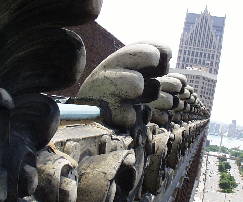 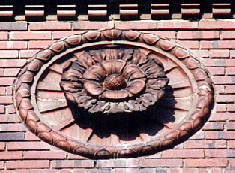 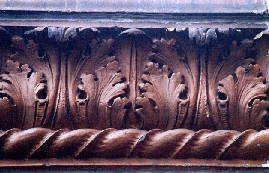 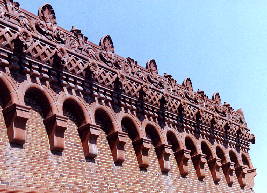 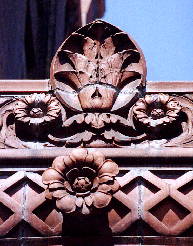 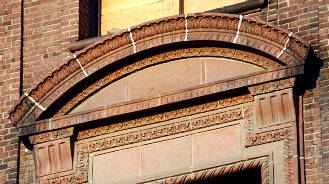 | ||
Aiw Member Username: Aiw Post Number: 5896 Registered: 10-2003 |
Michikraut, I agree, however it seems more often than not Vitrolite storefronts are not kept up or given much thought. Here's one from Windsor: 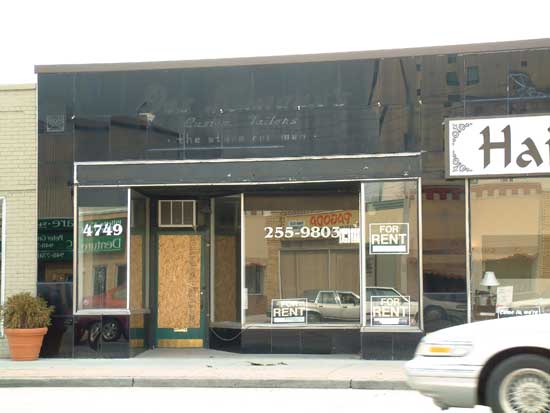 | ||
Burnsie Member Username: Burnsie Post Number: 692 Registered: 11-2003 |
Vitrolite is made of mechanically ground, pigmented plate glass that has mirror finish with no distortion, and was patented by Libbey-Owens-Ford in the first decade of the 20th century. www.cr.nps.gov/hps/tps/briefs/ brief12.htm |